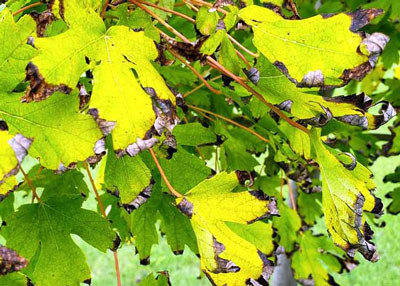Gardeners Ask About Leaves
Here are the questions I’m most often asked about plants’ leaves. Hopefully you’ll find them of interest.

“What plants have the best fall color?”
With the exception of East Texas, our state doesn’t win many awards for its autumn foliage. For big areas of the state, the best sources of fall color include Shumard red oak, Chinese pistachio, crape myrtles, sweetgums (sandy, acidic soils only), ornamental pears (short productive life expectancy due to major trunk failures), Shantung maples and, for shade, Japanese maples, dogwoods (acidic soils), and for yellow fall color, ginkgoes.
“Do I need to keep the leaves picked up off my lawn?”
Yes. Leaves will pack down and trap moisture. Dark, moist conditions lead to turf disease problems. Plus, if you don’t pick the leaves up, they will act as a thermal blanket. The grass won’t acclimate to progressively colder conditions, and if an extremely cold spell were to push through early in the season and blow the leaves away, damage could be more severe than necessary.
“How should I gather the leaves – by raking or with the mower?” Either way works, but if you run them through the mower and bag them, you can use them immediately as a mulch in shrub beds and perennial gardens. They’re also ideal for use in the compost.
“Are there any kinds of leaves that shouldn’t go into the compost pile? I hear that walnut, pecan and oak leaves keep other plants from growing.”
People talk about those leaves having tannin or tannic acid, but that’s really not a factor in the garden. Many of us have been growing in oak, pecan and even redcedar woodlands for years without any issues. The humus that accumulates beneath those trees is rich and wonderful.

“Why do my Japanese maples’ leaves all have brown edges?”
That’s moisture stress, and it’s the cumulative effect of high temperatures, dry soils and low humidity. The edges of the leaves are farthest from the roots, so they’re the last places to get water and the first places to dry out. That’s where scorch will show up.
“What’s happening to the blades of my St. Augustine in the fall? They turn yellow, then brown.”
That sounds like the fungus called brown patch (now being referred to by Texas A&M as “large patch”), and it shows up everywhere across North Texas once it starts to turn to cooler and rains pick up again. You’ll probably also notice that the yellowing/browning occurs in fairly round circles initially. Pull on a few of the blades within one of those circles. If you see decayed tissues at the bases of the blades, that’s where the fungus is active. It isn’t fatal, but it certainly does weaken the grass. Treating with a labeled fungicide such as Azoxystrobin will stop any further damage.
